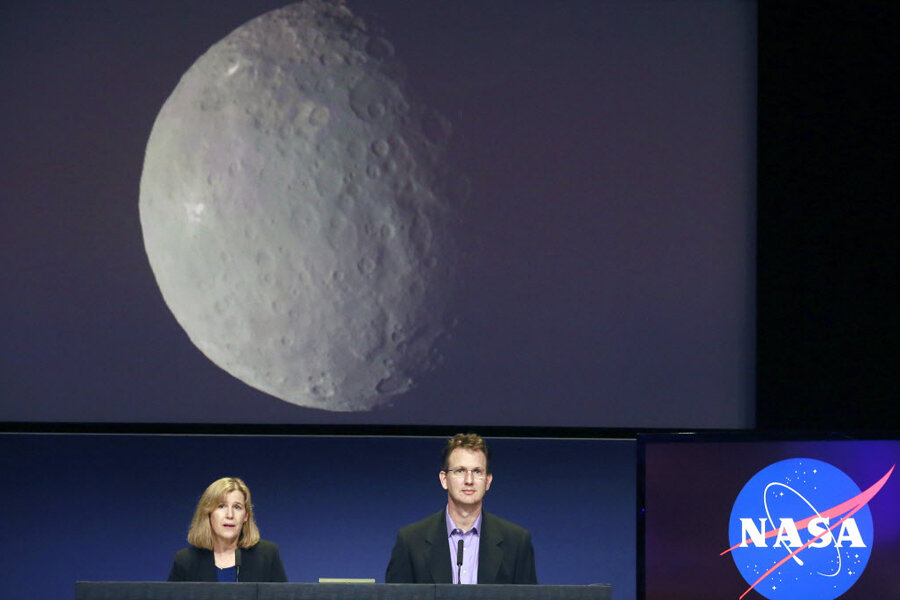Dawn closes in on Ceres: What astronomers hope to learn
Loading...
After traveling 3.1 billion miles, with a 14-month layover at the asteroid Vesta, NASA's Dawn spacecraft is set for arrival at the dwarf planet Ceres Friday morning.
Success during the highly anticipated arrival would mark the the first time a spacecraft has visited a dwarf planet, an object whose traits put it somewhere between a planet and a moon in the solar system's menagerie of objects.
Like Vesta, Ceres orbits the sun as part of the main asteroid belt, a collection of primitive objects that fall between the orbits of Mars and Jupiter. Where Vesta, the second largest object in the asteroid belt after Ceres, is rocky, Ceres is thought to be roughly 25 percent water ice.
Data that Dawn delivers from Ceres will allow planetary scientists to compare the two objects to better understand the conditions that existed in this region when the planets were forming some 4.56 billion years ago.
These are "two intact protoplanets from the very dawn of the solar system," says Carol Raymond, a planetary scientist at NASA's Jet Propulsion Laboratory in Pasadena, Calif., who also heads the lab's program for studying small solar-system objects. "They are two fossils we can investigate to understand what was really going on at that time."
Researchers hold Jupiter responsible for this junkyard of rubble left from planet-building. Jupiter's gravitational influence stirred up the region sufficiently to prevent another Earth-size planet from forming there.
Ceres accounts for about 25 percent of the total mass of all the objects in the belt. Based on its slightly squashed shape, Ceres is thought to host a large rocky core, followed by a layer of water ice and an outer crust of dust.
Dawn's measurements of surface features, especially the shapes and sized of the numerous craters that pock the surface, will provide an important test of this hypothesized blueprint for Ceres' structure.
The relatively high abundance of water ice researchers attribute to Ceres has raised the intriguing possibility that the dwarf planet briefly hosted liquid water in early its history, as radioactive decay from minerals in a rocky core heated the underside of the ice layer and melted it.
This could have provided a habitat for microbial life, notes Dr. Raymond.
"Ceres is a lot like Europa and Enceladus," icy moons of Jupiter and Saturn, she said during a briefing earlier this week previewing Dawn's arrival.
The three would have had similar conditions initially, she says, although currently Ceres is unlikely to have a liquid layer. Unlike Ceres, however, the other two moons have a ready source of internal heat: friction produced via gravitational interactions with their host planets and sibling moons. Ceres, an orphan only 590 miles across, would have quickly cooled.
One of the intriguing questions is whether that ice retains enough heat to be subject to convection, Raymond says.
That could help explain last year's announcement that scientists had detected water vapor around Ceres, based on data from the European Space Agency's Herschel Space Observatory, a space-based infrared telescope.
Not long after, another team reported evidence from ground-based visible and near-infrared measurements for water-related alteration of Ceres' surface and posited that the features they saw could result either from eruptions of ice similar to volcanic eruptions or to comet-like outgassing of water vapor.
So far, views of Ceres's surface that Dawn has been sending back as it approaches the dwarf planet don't reveal the kinds of surface features associated with cryovolcanism, Raymond says.
Another, perhaps related, mystery involves small bright patches on Ceres, which appeared in images Dawn took during the spacecraft's final approach. These tend to appear at low latitudes.
Two in particular shine brightly from the floor of a crater about 60 miles across.
"Suffice it to say, these spots were extremely surprising to the team," Raymond says. So far, Dawn hasn't gotten close enough to be able to look at the spots in more detail. "But it's apparent brightness is completely off-scale," suggesting highly reflective material that could contain ice or salts.
The crater falls within a sector of Ceres that appeared to be a source for water vapor Herschel detected.
"The team is really excited about this feature because it is really unique in the solar system," she says.
If Dawn's final travel day goes as expected, Ceres's gravity will capture the spacecraft at about 7:20 a.m. Eastern time tomorrow, although mission controllers won't know if the capture succeeded until several more hours have passed.
Over the course of its visit, which is expected to last at least until June 2016, Dawn will orbit Ceres at four different altitudes, each closer to the surface than the previous altitude. At its most distant orbit, Dawn will track the dwarf planet's rotation. By November, Dawn will have moved to within 230 miles of the surface for detailed measurements of composition of Ceres's surface materials and for gravity measurements that can reveal information about the object's interior structure.








